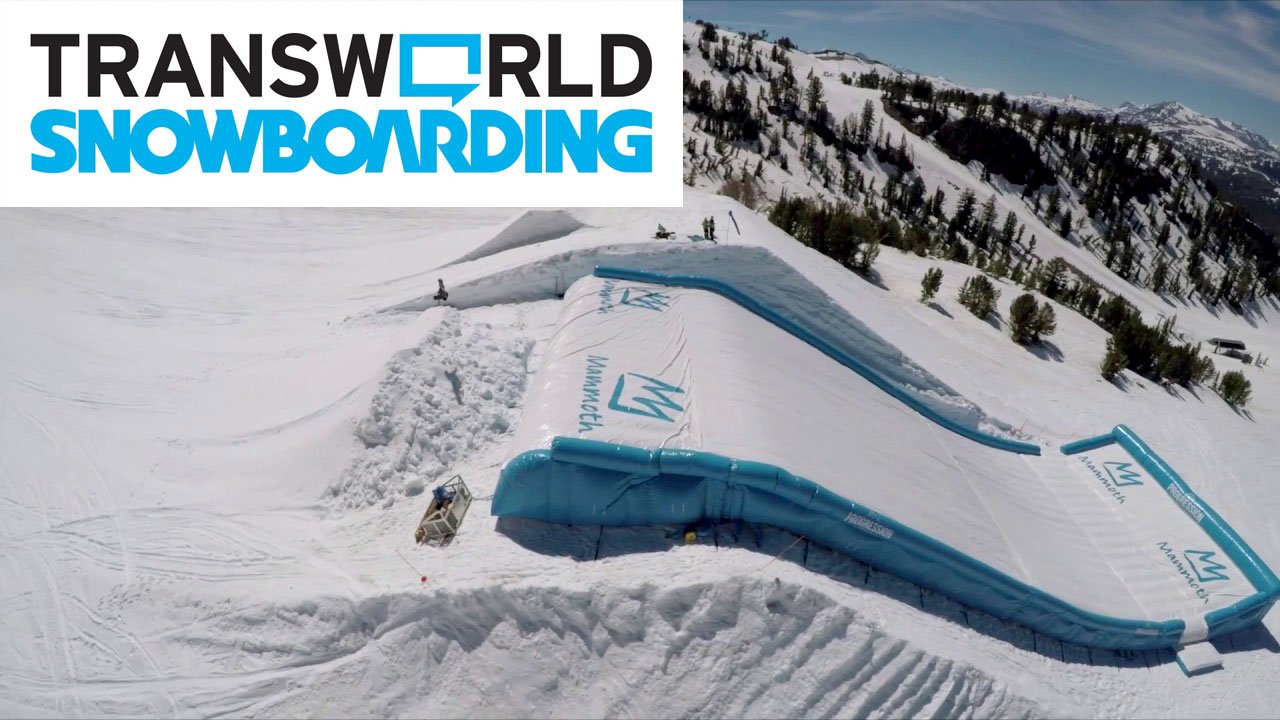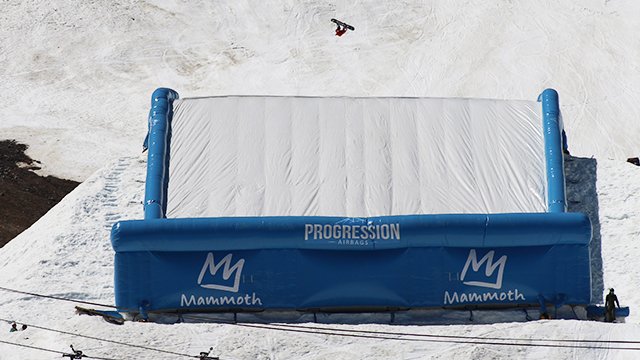
Progression Airbags Featured on Transworld Snowboarding
Original Article Posted on Transworld Snowboarding | Photo Credits: Javier Silva
With an upcoming Olympic season approaching and a precursor of qualifying events to prepare for, training for snowboarding’s hucking hopefuls is in full swing. And with that training, amidst our normal summer newsfeed of glaciers and good times, a new shape has risen out of the slush.

The new Progression AirBag set up at Mammoth Mountain. PHOTO: Javier Silva
The new shape is a sloped airbag made by Progression AirBags that is helping riders learn their tricks from start to snow in a safer environment than ever before. First conceived to push the level of slopestyle riding, Marc-André Tarte of Acrobag teamed up with Aaron Coret and Stephen Slen of Katal Innovations in the Squamish area for a customized airbag that mimicks the grade of an actual landing instead of just a flat pillow.
The result of their planning is a 200 ft. long, 77 ft. wide bag that weighs around 12,000 lbs. and separates into multiple pieces for travel. Complete with a 35 ft. deck, landing and walls to prevent the athletes from sliding onto the ground, the first ever Progression AirBag was set up at Mammoth Mountain this past month for visiting and hometown pros to train.

Zeke Oppegaard airing one out into the air-filled landing. PHOTO: Javier Silva
U.S. Team riders Hailey Langland and Chris Corning were two of the many riders attempting new tricks into the bag. Both coming off big seasons, Hailey taking gold in Women’s Big Air at X Games and Chris holding his own in some major competition stops, here is what they had to say:
Hailey Langland:
Q: The slope/jump bag is a newer addition to the training camps–can you describe what it’s like hitting it?
The bag is basically a gigantic bouncy house, material wise. Speaking from my personal experience, the bag is definitely a hit or miss. If you fall on it the right way, you won’t feel a thing. I have literally landed upside down—pretty much on my head—and didn’t feel it. But if the bag is kind of sticky or you fall on it wrong or land a certain way it can whip the living daylight out of you.
Q: Traditional airbags didn’t have the ability to mimic a landing, so this one seems like a game changer with learning new tricks. You’ve already been dabbling in doubles without the added security of the bag, so will this change how you try new variations or other tricks entirely?
I’ve only tried and done one double ever in my life, and so to have this kind of resource is super exciting for me. It’s not only to try and get comfortable with going upside down twice, but even to try basic tricks that I’m terrified of. FYI switch backside is literally my kryptonite.
Q: Having this type of facility when it comes to slopestyle contests and heading into the upcoming contest season and an Olympic year, how do you think this will affect women’s slope and big air in general in 2017-18?
I have mixed emotions about going into the Olympics this season. I think that everyone knows, on the women’s side of things, if you don’t at least have a double cork, your chances of being on the podium are pretty low. Which makes me so excited because it means we are going to see the highest level of competition and progression from the ladies. Ever. But it also makes me super nervous and antsy from a competitor’s stand point. Every day that you know someone else is on that bag, they’re learning something new, and you’re not.
Chris Corning:
Q: The slope/jump bag is a newer addition to the training camps–can you describe what it’s like hitting it?
I would describe hitting the airbag as a big Slip ‘n Slide if you hit it right, or getting your board caught in a really sticky situation that sends you into a really bad rag doll.
Q: Traditional airbags didn’t have the ability to mimic a landing, so this one seems like a game changer with learning new tricks. To go from learning doubles/triples/etc on traditional airbags/regular jumps/etc to this method, are you guys learning things so much faster? Is it game changer with being able to try new things?
Having the airbag is a real game changer. You have to go into learning new tricks with the right attitude, though. You can go into it thinking you can chuck your body and forget about the mechanics of how to throw the trick. If you learn your trick without your mechanics and your brain kinda lagging because [the airbag] is soft and you can fall, when you go into the jump and actually try the trick it’s going to be a lot different—you need your mechanics and your brain in full effect because you do have to land it! If you do it the right way, I think you can progress really fast!
Q: For the quad 1800 that you just stomped, you said you didn’t use the bag to learn it–can you describe the process of learning that trick and perhaps touch on why the bag was not a necessary component of that?
For my quad 1800 I did not use the bag. For me, I like learning things straight to snow because of the reasons in the last question. Trying the trick on that small of a jump was kind of a worry for me because no one has done it that small yet. They have all had massive jumps built just for trying the trick. But I sent some triples without popping and just going safety seat because I knew that where I needed the next flip. I then went big on triple and tried to throw it slow, and then the next time I tried the quad. It took me five tries and two days, but I got it.
Q: For quads and/or any other trick you want to learn or just dial in, how do you see the bag fitting into the process in a general sense?
Well, I definitely see myself using it when there is no snow, just to keep my air awareness in high intensity over the summer. Keeping my tricked dialed over the summer will be key on the airbag, I think. I see myself using it in the future, for sure though!

Kolman Lecroy landing in the new Progression AirBag. PHOTO: Javier Silva
The progression bags are just one of the many things Marc-André Tarte has given to snowboarding. With an impressive riding resume himself, Tarte was the first ever to land a 1260 back in 2002 and has worked with Max Henault over in Quebec who trains names like Seb Toots, and Max Parrot. Maximise, the camp ran by Henault will be receiving a Progression Airbag in the near future as well.
Hate or love the airbags, Tarte doesn’t care, and they seem to be here to stay. With the Mammoth Progression AirBag already making waves, Marc is currently installing a second one for the U.S. Snowboarding Team in Utah Olympic Park, a third in Quebec, and has orders for more.



